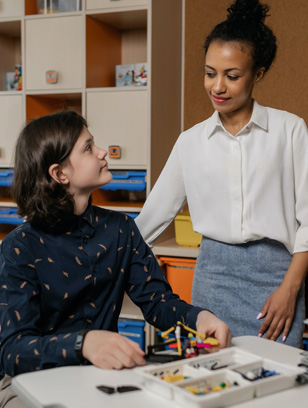As schools and districts focus on state standards, scope and sequence, and test scores, they often neglect one of the most important factors in student achievement. Positive student-teacher relationships, research shows, have a huge impact on learning.
Why Positive Student-Teacher Relationships Matter
The research is clear: Student-teacher relationships significantly impact teacher effectiveness and student achievement.
John Hattie’s meta-analysis Visible Learning is perhaps the best-known study on this topic. Hattie synthesized 800 meta-analyses relating to achievement. He found that numerous student-teacher relationship variables were among the most influential factors on student performance. These include empathy, warmth, encouragement, authenticity, and respect for student backgrounds.
Hattie said, “It is teachers who have created positive teacher-student relationships who are more likely to have above average effects on student achievement.”
Research aside, it’s common sense that students will work harder and learn better from teachers who care. Think about relationships you’ve had with your bosses, or with your own teachers in the past. How did the quality of those relationships impact your work ethic and performance?
A student who feels respected, cared for, and connected to their teacher has increased motivation to listen, learn, and achieve.
6 Strategies to Build Positive Student-Teacher Relationships
So, positive student-teacher relationships matter. But how can you foster a bond that encourages learning, especially if you have 20-plus students in your classroom? Try these six tips.
1. Believe that all students can succeed.
Your beliefs about your students will subconsciously affect how you treat each child in your classroom. For this reason, you must believe that every child is capable of succeeding. In addition, you must expect them to do so.
The next step is to clearly demonstrate these beliefs to your students. Show that you expect good behavior, effort, and improvement from every child in your classroom. Push them to achieve more than they thought possible. If you don’t believe your students can learn and improve, why should they try?
Of course, some students will need more support than others. Hold them to high standards, but support them along the way. Scaffold your lessons, offer helpful resources, and teach according to your students’ learning styles. Provide extra help as needed.
2. Get to know your students.
Take the time to know your students as individuals. Learn about their families, backgrounds, interests, likes and dislikes.
A “Getting to Know You” questionnaire at the beginning of the year is helpful. Other strategies include talking to your students at the beginning and/or end of class, or having students keep a journal that you regularly read and respond to.
Once you learn information about your students, bring it up in conversation. Asking, “How did your soccer game go?” or, “Did you get to see the latest Marvel movie yet?” means more to your students than you might expect.
3. Say hello and goodbye to every student, every day.
Connecting with students in the middle of a lesson isn’t easy. It’s important to take advantage of time before and after class to build bonds. Stand at the door as your students enter and as they leave, saying hello and goodbye to each child.
Perhaps you’ve seen viral greeting rituals, including having a special handshake with each student or allowing children to choose how they would like to be greeted (e.g. high five, fist bump, or smile).
However, it’s not important how you greet your students. What matters is that you take the moment to be fully present and attuned with every child. Make eye contact, smile, and use their name. In these seemingly small moments, relationships are built.
4. Laugh with your students.
Humor is an excellent way to build bonds with children. It also makes learning more engaging and encourages children to pay attention.
Make jokes, share funny stories, and don’t take yourself too seriously. Although humor shouldn’t be a priority in the classroom, you should work it in whenever possible. Through shared laughter, you’ll easily foster positive relationships with your students.
5. Provide students with choice.
As often as you can, provide flexibility and choice in assignments. Sure, you must assess specific skills and knowledge. However, how students demonstrate these abilities may vary. For instance, students can show vocabulary knowledge by writing a story, singing a song, or even making a collage.
You may also allow students to choose a book, design their own experiment, play a role in creating class rules and expectations, etc. The more you provide students with choice and autonomy, the more they’ll see that you value them as individuals.
6. Accept students–and their mistakes in the classroom.
Accept all students, despite their quirks and differences. Treat all students with the same respect and kindness, and don’t allow students to tease or disrespect one another in your classroom. Create an environment where all children can feel welcome and comfortable.
When you struggle to remain patient, remember that the children who need your love the most often show it in the most destructive ways. Try to give a fresh start each day, continue trying to connect, and consider how you can help even the most challenging children succeed. What skills are they missing? What do they need?
In addition, accept that mistakes are a natural part of learning, and instill this belief in your students. When they make mistakes, ask them, “What did you learn from that?” and celebrate the lesson learned.
Final Thoughts: Building Positive Student-Teacher Relationships
State standards and test scores are important, but we can’t forget the necessity of positive student-teacher relationships.
When students don’t feel comfortable or cared for in the classroom, learning becomes difficult. On the other hand, if a student feels connected to their teacher, they’re likely to flourish.

